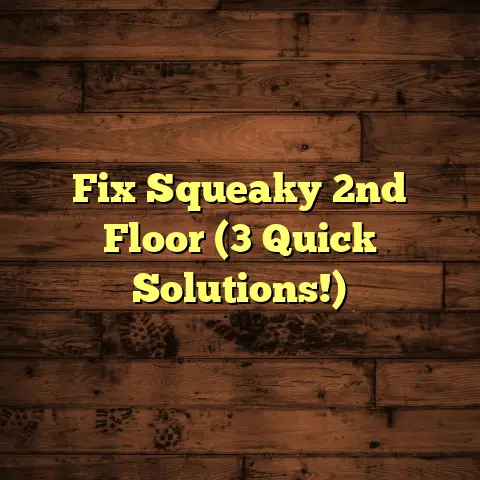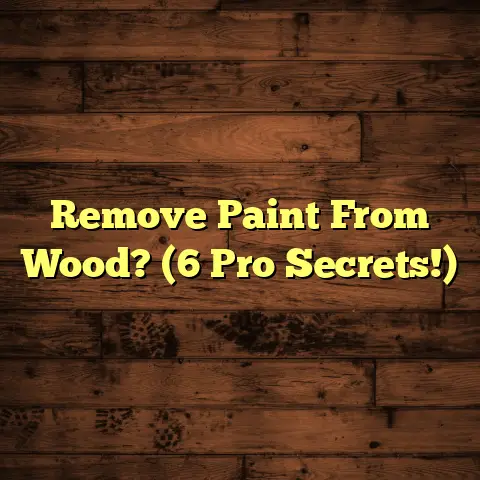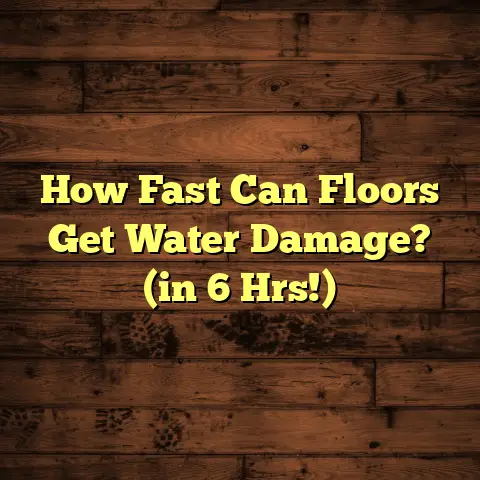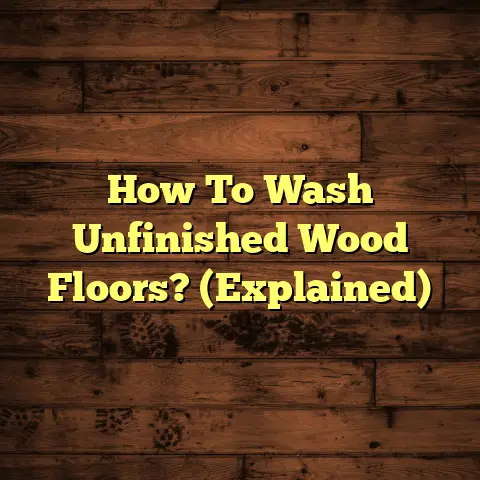How To Glue Down Vinyl Floor? (2 Glue Types!)
I’m excited to share my knowledge on a flooring topic that’s close to my heart: gluing down vinyl floors.
Over the years, I’ve seen incredible advancements in flooring tech, haven’t you?
One that really stands out is the rise of vinyl flooring, with its amazing durability and style options.
Recently, I saw a manufacturer roll out a new line of eco-friendly vinyl that’s made from recycled materials.
It’s a game-changer, showing how we can make our homes beautiful while being kind to the planet.
This guide is all about helping you master the art of gluing down vinyl floors.
I’ll walk you through everything, from understanding the types of vinyl to choosing the right adhesive.
Let’s dive in!
Section 1: Understanding Vinyl Flooring
So, what exactly is vinyl flooring?
It’s a synthetic flooring material designed to mimic the look of natural materials like wood, stone, or tile.
But it comes with added benefits like water resistance and easy maintenance.
There are a few main types you’ll come across:
- Luxury Vinyl Planks (LVP): These are designed to look like hardwood planks.
- Luxury Vinyl Tiles (LVT): These mimic ceramic or stone tiles.
- Vinyl Sheets: These come in large rolls and are great for covering large areas quickly.
I’ve found that vinyl flooring is super popular because it’s affordable, durable, and looks fantastic.
It’s a great option if you want the look of hardwood without the high price tag or maintenance headaches.
Now, when is gluing down vinyl the best choice?
I usually recommend it for high-traffic areas where you need extra stability.
Also, if your subfloor isn’t perfectly even, gluing can provide a more secure and level surface.
Think basements, kitchens, or commercial spaces where you want the flooring to stay put.
Section 2: Preparing for the Installation
Alright, let’s talk prep!
Before you even think about glue, you need to gather your tools and materials.
Here’s what I usually have on hand:
- Vinyl Flooring: Obviously!
Make sure you have enough to cover the area, plus a little extra for mistakes. - Adhesive: We’ll get into the different types in the next section.
- Utility Knife: For cutting the vinyl to size.
- Trowel: To spread the adhesive evenly.
- Roller: To ensure the vinyl adheres properly.
- Measuring Tape: Accurate measurements are key.
- Straight Edge: To guide your cuts.
- Pencil: For marking measurements.
- Cleaning Supplies: Vacuum, mop, and maybe some degreaser.
Now, let’s talk about the subfloor.
This is crucial.
The subfloor needs to be clean, dry, and level.
Trust me, I’ve seen installations fail because of a poorly prepped subfloor.
First, give it a good sweep and vacuum to remove any dirt or debris.
Then, mop it to get rid of any stubborn grime.
If there are any grease spots, use a degreaser.
Next, check for levelness.
I use a long level to identify any high or low spots.
If there are minor imperfections, you can use a self-leveling compound to smooth things out.
For larger issues, you might need to consult a professional to repair or replace the subfloor.
Finally, make sure the subfloor is dry.
Excess moisture can prevent the adhesive from bonding properly, leading to bubbles or peeling.
I usually use a moisture meter to check the moisture level.
It should be below the manufacturer’s recommended level for the adhesive.
Okay, almost there!
Don’t forget to acclimate the vinyl flooring.
This means letting the vinyl sit in the room where it will be installed for at least 48 hours.
This allows the vinyl to adjust to the room’s temperature and humidity, preventing it from expanding or contracting after installation.
I usually spread the vinyl out in the room to help it acclimate evenly.
Section 3: Choosing the Right Adhesive
Okay, this is where things get interesting.
Choosing the right adhesive can make or break your project.
There are two main types of adhesives I use for gluing down vinyl flooring:
- Pressure-Sensitive Adhesive (PSA)
- Full-Spread Adhesive
Let’s break them down.
Pressure-Sensitive Adhesive (PSA)
PSA, or “peel and stick,” is designed to create a bond when pressure is applied.
It’s like a super-strong sticker.
I love using PSA because it’s easy to apply and doesn’t require a lot of drying time.
You simply peel off the backing and stick the vinyl to the subfloor.
The benefit of using PSA is its ease of use and quick installation.
It’s also great for DIYers who might be intimidated by the more involved application of full-spread adhesives.
Ideal situations for using PSA are in residential settings, especially in areas with less moisture.
Think bedrooms, living rooms, or home offices.
I wouldn’t recommend it for bathrooms or basements where moisture levels can be higher.
Full-Spread Adhesive
Full-spread adhesive is a different beast.
It requires you to spread the adhesive over the entire subfloor before laying the vinyl.
This creates a much stronger and more permanent bond.
I often recommend full-spread adhesive for high-traffic or commercial spaces.
Think hallways, kitchens, or retail stores.
The benefits of full-spread adhesive are its strong bond and moisture resistance.
It’s designed to withstand heavy use and can handle higher levels of moisture without failing.
I’ve seen full-spread adhesive hold up beautifully in busy restaurants and bustling offices.
It’s definitely the way to go if you want your flooring to last for years.
Section 4: The Installation Process
Alright, let’s get to the fun part: installing the vinyl!
I’ll walk you through the process for both PSA and full-spread adhesive.
Gluing Down Vinyl with Pressure-Sensitive Adhesive (PSA)
- Prepare the Subfloor: As I mentioned earlier, make sure the subfloor is clean, dry, and level.
- Measure and Cut: Measure the area where you’ll be installing the vinyl and cut the vinyl to size.
I always add a little extra to account for any mistakes. - Peel and Stick: Peel off the backing of the PSA and carefully position the vinyl on the subfloor.
Start in one corner and work your way across, smoothing out any bubbles or wrinkles as you go. - Roll It Out: Use a roller to apply pressure to the vinyl, ensuring it adheres properly to the subfloor.
I usually go over the entire surface several times to make sure it’s fully bonded. - Trim the Edges: Use a utility knife to trim any excess vinyl around the edges of the room.
A straight edge will help you get a clean, professional-looking cut.
Tips for PSA:
- Work in small sections to prevent the adhesive from drying out before you can apply the vinyl.
- Use a sharp utility knife to get clean cuts.
- If you get any bubbles or wrinkles, gently lift the vinyl and smooth them out before rolling it again.
Gluing Down Vinyl with Full-Spread Adhesive
- Prepare the Subfloor: Again, clean, dry, and level is the name of the game.
- Measure and Cut: Measure and cut the vinyl to size, adding a little extra for mistakes.
- Apply the Adhesive: Using a trowel, spread the adhesive evenly over the subfloor.
Follow the manufacturer’s instructions for the correct trowel notch size and application rate.
I usually work in small sections to prevent the adhesive from drying out before I can lay the vinyl. - Lay the Vinyl: Carefully position the vinyl on the adhesive, starting in one corner and working your way across.
Smooth out any air pockets or wrinkles as you go. - Roll It Out: Use a roller to apply pressure to the vinyl, ensuring it adheres properly to the adhesive.
I usually go over the entire surface several times to make sure it’s fully bonded. - Curing Time: Allow the adhesive to cure according to the manufacturer’s instructions.
This can take anywhere from 24 to 72 hours.
Avoid walking on the flooring during this time. - Trim the Edges: Use a utility knife to trim any excess vinyl around the edges of the room.
Tips for Full-Spread Adhesive:
- Follow the manufacturer’s instructions for the adhesive. They know their product best!
- Work in small sections to prevent the adhesive from drying out.
- Use the correct trowel notch size to ensure the adhesive is applied at the correct thickness.
- If you get any air pockets, use a roller to push them out.
- Be patient and allow the adhesive to cure fully before walking on the flooring.
Section 5: Troubleshooting Common Issues
Okay, let’s be real.
Sometimes things don’t go as planned.
Here are some common issues I’ve encountered and how to fix them:
- Bubbles or Wrinkles: This usually happens when the vinyl isn’t properly adhered to the subfloor.
For PSA, gently lift the vinyl and smooth out the bubbles or wrinkles before rolling it again.
For full-spread adhesive, use a roller to push out any air pockets.
If the bubbles or wrinkles persist, you may need to reapply the adhesive. - Uneven Seams: This can happen if the vinyl isn’t cut properly or if the subfloor isn’t level.
Use a straight edge and a sharp utility knife to trim the edges of the vinyl for a clean, even seam.
If the subfloor is uneven, you may need to use a self-leveling compound to smooth it out. - Adhesive Failure: This can happen if the adhesive isn’t applied properly or if the subfloor is too wet.
Remove the vinyl and clean the subfloor thoroughly.
Make sure the subfloor is dry before reapplying the adhesive.
Follow the manufacturer’s instructions for the adhesive application.
Section 6: Maintenance and Care for Glued Vinyl Flooring
Once your vinyl flooring is installed, you’ll want to keep it looking its best.
Here are some tips for maintaining glued vinyl floors:
- Regular Cleaning: Sweep or vacuum regularly to remove dirt and debris.
Mop with a mild detergent and water.
Avoid using harsh chemicals or abrasive cleaners, as they can damage the vinyl. - Protect from Scratches: Use felt pads under furniture legs to prevent scratches.
Avoid wearing shoes with sharp heels or cleats on the flooring. - Handle Repairs: If a section of vinyl flooring is damaged, you can usually replace it.
Use a utility knife to cut out the damaged section and remove it.
Apply adhesive to the subfloor and install a new piece of vinyl, matching the pattern and color of the existing flooring.
Conclusion
Wow, we covered a lot!
Gluing down vinyl flooring can be a rewarding DIY project.
It enhances the beauty and functionality of your space.
I hope this guide has given you the confidence to tackle your own flooring project.
Remember, choosing the right adhesive and preparing the subfloor are key to a successful installation.
And don’t be afraid to ask for help if you get stuck!
Happy flooring!
Call to Action:
I’d love to hear about your experiences with gluing down vinyl flooring!
Have you tried it yourself?
Did you seek professional help?
Share your stories and projects in the comments below or on social media.
Let’s inspire each other to create beautiful and functional spaces!





